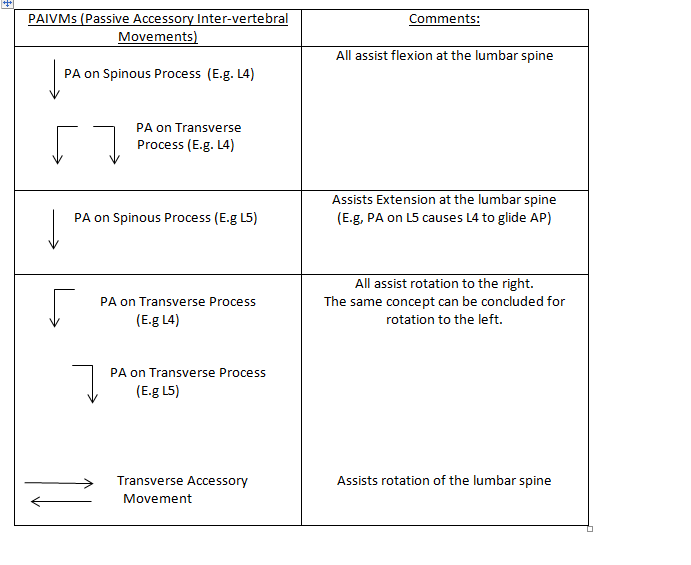Manual Therapy Techniques For The Lumbar Spine
Original Editors - Jenny Arnatt, Tabitha Eddleston, Tori Jovcic, Lizzie Wakeham
Lead Editors - Your name will be added here if you are a lead editor on this page. Read more.
Introduction[edit | edit source]
Mobilisations[edit | edit source]
Joint mobilisation is a treatment technique which can be used to manage musculoskeletal dysfunction [1]Hertling et al (1996). The techniques are performed by physiotherapists, and fall under the category of manual therapy. Spinal mobilisation is described in terms of improving mobility in areas of the spine that are restricted [2](Korr 1977). Such restriction may be found in joints, connective tissues or muscles. By removing the restriction by mobilisation the source of pain is reduced and the patient experiences symptomatic relief. This results in gentle mobilisations being used for pain relief while more forceful, deeper mobilisations are effective for decreasing joint stiffness. [3] (Maitland 1986).
Background[edit | edit source]
Mobilisations of the Lumbar Spine
[edit | edit source]
Central Posteroanterior (PA) Mobilisation Technique[edit | edit source]
For this manual therapy technique, the patient is often positioned in prone with their arms by their side and a pillow under their abdomen for comfort [4] (Powers et al, 2009). A PA mobilization is then performed by a physiotherpist by placing their thumb or pisiform over the spinous process of a vertebrae and applying a posteroanterior force.
PAs are a commonly used manual therapy technique that has shown to be effective at reducing pain in patients with low back pain (LBP) (Shum, Tsung and Lee, 2012). So far, evidence suggests immediate pain relief following treatment, and also some evidence suggests an increased range of movement (ROM) of lumbar extention (McCollam and Benson, 1993, Shum, Tsung and Lee, 2012, and Powers et al, 2009)
N.I.C.E guidlines (2009) therefore suggest lumbar mobilizations should be included in a 12 week course of manual therapy for patients with non-specific LBP.
Recording[edit | edit source]
Prescription of Mobilisations[edit | edit source]
Thus far, there is no definitive evidence for the optimum duration, frequency or amplitude for mobilisation techniques. However, Most researchers have investigated subject responces' to 3 cycles of 60 second mobilisation which have shown to have positive effects [5] and [6]. However, [7]suggest that the duration and frequency should be tailored to the patient's irritability and the preference of both patient and therapist.
Moreover, it is generally agreed that the oscilliation depth and amplitude of movement is dependent on the patients symptoms.
If the patient's main symptom is pain then oscillation depth should remain shallow (<55%) and should be maintained within a pain free range (e.g. Grade I and II). However, if the patient's main complaint is of stiffness then the depth of oscillation can progress to end of range providing pain is tolerable (e.g. Grade III and IIII)
Maitland Scale of Mobilisations[8]:
Grade I - Small amplitude + slow oscillations in pain free zone (<25% ROM)
Grade II- Large amplitude + slow oscillations in pain free zone (<55% ROM)
Grade III- Large amplitude + slow oscillations mid to end of range
Grade IIII- Small amplitude + slow oscillations at end of range
References[edit | edit source]
- ↑ Hertling D., and R.M. Kessler. Management of Common Musculoskeletal Disorders. Baltimore: Lippincott, Williams & Wilkins, 1996.
- ↑ Korr IM (1977): The neurobiologic mechanisms in manipulative therapy. New York, Plenum Press.
- ↑ Maitland GD (1986): Vertebral manipulation, 5th ed. Sydney, Butterworths.
- ↑ Powers, C.M., Beneck, G.J., Kulig, K., Landel, R.F. and Fredericson, M., 2008, "Effects of a Single Session of Posterior-to-Anterior Spinal Mobilization and Press-up Exercise on Pain Response and Lumbar Spine Extension in People with Nonspecific Low Back Pain", Journal of the American Physical Therapy Association
- ↑ Krouwel, O., Hebron, C. and Willett, E., 2010, "An investigation into the potential hypoalgesic effects of PA mobilisations on the lumbar spine as measured by pressure pain thresholds (PPT)",Manual Therapy, Vol. 15, Pp. 7-12
- ↑ Goodsell, M., Lee, M and Latimer, J., 2000, "Short-Term Effects of Lumbar Posteroanterior Mobilization in Individuals With Low-Back Pain",Journal of Manipulative and Physiological Theraputics, Vol. 23, No. 5.
- ↑ Cite error: Invalid
<ref>tag; no text was provided for refs namedMaitland, 2005 - ↑ Cenage, G., 2002, "Joint Mobilization and Manipulation", Encylopedia of Nursing &amp;amp; Allied Health, Vol.3, accessed 8 January 2013 at [&amp;lt;http://www.enotes.com/joint-mobilization-manipulation-reference/&amp;gt;].







